Tech
Alchemy Launches ‘Pipelines’ to Streamline How Blockchain Engineers Extract Data

April 24 (PROTOCOL VILLAGE EXCLUSIVE): Alchemy, a blockchain development firm, launched “Pipelines,” a new tool that allows engineers to build and maintain a data pipeline with just a few clicks, according to the team: “This is Alchemy’s first indexing product since it acquired Satsuma last year. A data ‘pipeline’ is how engineers extract data from a ‘source’ and send it to a ‘destination’ – often a database owned by the engineers. Before Pipelines, this process could take engineers up to a week to set up. With Pipelines, a single engineer can set up a data pipeline in under five minutes and start getting data almost immediately, saving Web3 projects hefty engineering costs and time.”
Chainlink’s CCIP Enters ‘General Availability’ for Permissionless Use
April 24: The Chainlink Cross-Chain Interoperability Protocol (CCIP) has officially entered “general availability,” or “GA,” according to the team: “Any developer can now permissionlessly use CCIP to securely transfer onboarded tokens cross-chain, send arbitrary messages to smart contracts on another blockchain, or simultaneously send data and value together through CCIP’s unique support for Programmable Token Transfers. Supported blockchains include Arbitrum, Avalanche, Base, BNB Chain, Ethereum, Kroma, Optimism, Polygon, and WEMIX, with many more to come in the future.”
Metis Decentralized Sequencer Upgrade Adds New ‘Mining’ Feature
April 23: Metis unveiled phase 2 of its decentralized sequencer, adding new technical features and introducing “Sequencer Mining” for users, according to the team: “With Sequencer Mining, sequencer nodes will earn METIS tokens for their role in processing transactions and generating blocks within blockchain networks using Layer 2. LST providers will operate sequencer nodes, and users will be able to stake via these providers, unlocking liquid tokens in the process. The Metis community chose Artemis Finance and Enki Protocol as the two LST protocols for the Alpha Phase.” (METIS)
Mina Foundation, O1Labs Plan Integration With Celestia DA
April 23: The Mina Foundation and o1Labs are announcing their collaboration with Celestia to integrate Celestia’s modular Data Availability (DA) layer with Mina Protocol and streamline the integration of zkApps in Web apps. According to the team: “This collaboration addresses the issue of ensuring that all data in a blockchain block is published to the network, making it easier to identify a malicious transaction hidden within that block and support secure scaling.”
Ethereum Name Service Integrates With ICANN-Approved Top-Level Domain ‘.Box,’
April 23: Ethereum Name Service (ENS), an open-source blockchain naming protocol, has successfully integrated with .box, an ICANN-approved top-level domain (TLD), according to the team: “Users in both Web3 and Web2 can access email, host websites and interact on Ethereum using a single domain name. By enabling immediate compatibility with mainstream platforms like Google Chrome, Safari, Outlook and G Suite, .box domains facilitate the integration of on-chain digital identities into existing infrastructure, bridging the gap between Web2 and Web3 technologies.”
Galaxy, Lightspeed Lead $15M Raise for Turnkey, Crypto Wallet Startup From Former Coinbase Employees
April 23: Turnkey, a company that builds wallet infrastructure for blockchain developers, has raised $15 million in a Series A funding round led by Lightspeed Faction and Galaxy Ventures. Co-founded by a pair of former Coinbase employees who helped build the U.S. crypto exchange’s custody service, Turnkey aims to help application developers build user-friendly blockchain wallets.
Turnkey co-founders Jack Kearney and Bryce Ferguson (Turnkey)
Protocol Village is a regular feature of The Protocol, our weekly newsletter exploring the tech behind crypto, one block at a time. Sign up here to get it in your inbox every Wednesday. Project teams can submit updates here. For previous versions of Protocol Village, please go here. Also please check out our weekly The Protocol podcast.
Neura, Ankr’s Layer-1 Chain for AI, Releases Public Testnet
April 22: Neura, the EVM-compatible layer-1 blockchain for AI from the team at Ankr, built on Cosmos SDK, just released its public testnet, now available for developers looking to build dApps that fuse AI and Web3, according to the team: “Neura provides solutions to critical AI startup challenges like securing funding, obtaining GPU resources, and storing data efficiently with a novel blend of tech. Neura’s “Road To Mainnet” program will include a developer competition with top projects splitting $100,000 in grants. It will also incorporate rewards for ANKR token holders, with special benefits like receiving the first chance to invest in new AI model tokens.”
DODOChain Launches as ‘Omni Trading Layer3’ Powered by Arbitrum, EigenLayer, AltLayer
April 22 (PROTOCOL VILLAGE EXCLUSIVE): The DODO team, which previously developed the “Proactive Market Maker” algorithm and features including a cross-chain swap aggregator, announced the launch DODOchain, an Omni Trading Layer3, powered by Arbitrum Orbit, EigenLayer, and AltLayer, according to the team: “DODOchain stands as the pioneering layer-3 solution, seamlessly bridging layer 2s of Bitcoin and Ethereum, with a focus on consolidating liquidity from diverse chains.” According to a press release: “DODOchain will leverage EigenDA to utilize Ethereum’s consensus and security features. DODOchain will also work as a restaked rollup, being one of the first Actively Validated Services (AVSs) in the Eigenlayer ecosystem. DODOchain has adopted AltLayer’s novel restaked rollups infrastructure based on EigenLayer’s powerful restaking mechanism. This not only strengthens network security and decentralization but also facilitates rapid deployment and cross-chain interoperability, creating a smoother and more interconnected blockchain experience for users.” A testnet is live.
Omni Network, Interoperability Protocol, Launches Mainnet on Arbitrum and Optimism
April 22 (PROTOCOL VILLAGE EXCLUSIVE): Omni Foundation, supporting Omni Network, which is a layer-1 chain and Ethereum-focused interoperability protocol powered by EigenLayer restaking, announced the launch of Omni Network’s mainnet on the Ethereum layer-2 networks Arbitrum and Optimism. According to the team: “Omni is an L1 to unite Ethereum rollups, offering access to all users and liquidity of the Ethereum ecosystem. The launch follows Omni’s token generation event and airdrop with 3M $OMNI sent to Omni and Ethereum ecosystems.”
Celo Chooses Optimism, Concluding Bake-Off Among Layer 2s
Io.net, Aethir Partner to Create ‘Airbnb of GPUs’
April 22: Io.net, a decentralized network for GPU Compute that raised $30 million in March, and Aethir, a project for decentralized cloud computing, have partnered to create what they’re calling the “Airbnb of GPUs,” merging over 640,000 computing units to democratize supercomputing. According to the team: “This disruptive alliance, announced ahead of a $100M token airdrop, aims to make high-powered computing accessible globally, breaking down cost and geographic barriers.”
Foundation Behind Polkadot Reveals 10M DOT ($74.5M) Prize Pool After Wood Unveils JAM
April 22: Web3 Foundation (W3F), the foundation behind the Polkadot ecosystem, has announced a 10 million DOT ($74.5 million) prize pool, “to foster diversity within the development of JAM, a protocol combining elements of both Polkadot and Ethereum,” according to the team: “Through the JAM Implementer’s Prize, W3F are seeking developers to diversify and strengthen network resilience. One of the key features of JAM is the guaranteed seamless compatibility for developers. W3F’s mission is to nurture cutting-edge applications for decentralized web software protocols.” JAM stands for “Join-Accumulate Machine,” and it provides a “global singleton permissionless object environment, much like the smart-contract environment pioneered by Ethereum, paired with secure sideband computation parallelized over a scalable node network,” according to the graypaper by Polkadot founder Gavin Wood, who was also a co-founder of Ethereum.
Gavin Wood made a presentation on JAM at Token 2049 in Dubai last week. (@mattunchi via Polkadot)
ORA’s ‘On-Chain AI Oracle’ Plans Expansion to Polygon PoS In Addition to Ethereum
April 19: ORA’s OAO (stands for On-chain AI Oracle), describing itself as “the world’s first AI oracle,” is gearing up to launch on Polygon’s PoS network, according to the team: “OAO was called more than 10,000 times in under a month on Ethereum’s Sepolia testnet. In March, OAO was launched on Ethereum mainnet. Now, developers, protocols and dApps will be able to verify and use LLM inferences on Polygon. The OAO (Onchain AI Oracle) launch onto Polygon is critical for scalability, speed and convenience. Developers and users will be able to cheaply and efficiently access verifiable inference data on-chain.”
Telos to Work With R&D Firm Ponos on Hardware-Accelerated Ethereum ZkEVM
April 19: Telos Foundation, which supports the Telos blockchain, said it will work with Ponos Technology, a zero-knowledge-proof research and development firm, to develop an end-to-end optimized, hardware-accelerated Ethereum layer 2 network featuring SNARKtor, the Telos-developed decentralized recursive proof aggregator. According to the team: “Telos will also work with several other new partners during the L2’s development cycle, including Digital M.O.B. (Ethereum dev team), ATKA (Web3 incubator) and Cometh (dev team led by ETH France President Jerome De Tychey).”
Runes DEX Secures $2 Million in Seed Investment to Pioneer AMM on Bitcoin
April 19: Runes DEX, an automated market maker (AMM) platform for runes on Bitcoin, announced the successful closure of its $2 million seed investment round. According to a press release: “This crucial funding milestone has garnered support from prominent blockchain investors including Kenetic Capital, Mechanism Capital, Auros Ventures, Future Fund and Boosty Labs. Notable industry pioneers backing this round are Pascal Gauthier, CEO of Ledger; 0xMaki, founder of SushiSwap; and AOI, founder of AOI.com.”
Safe, for ‘Smart Accounts,’ Completes Acquisition of Crypto Business Wallet Multis
April 18: Safe, a provider of blockchain smart accounts, has “welcomed the senior leadership team of Multis to the Safe Ecosystem Foundation and completed the strategic acquisition of the Multis source code,” according to the team: “Thibaut Sahaghian, former CEO of Multis, will take on the role of network abstraction lead within the Safe ecosystem. Together, the Safe and former Multis team will collaborate to solve the complexities of cross-chain interaction through network abstraction, with the goal of enabling users to manage assets across diverse blockchain networks effortlessly.” Multis offers a crypto business wallet, according to its website.
Thibaut Sahaghian, network abstraction lead, Safe (Safe)
Aethir, Decentralized Network for GPU Resources, Introduces ‘Edge’ Device Powered by Qualcomm
April 18: Aethir, a project for decentralized cloud computing, introduced the Aethir Edge device powered by Qualcomm, “a significant leap in edge computing with a decentralized infrastructure that enhances reliability by distributing capacity across peer nodes,” according to a message from the team. “Aethir Edge is the hardware component of the Aethir DePIN stack, and it is, in all aspects, a hardware device built to power the next generation of GPU cloud computing. Through Aethir Edge, we enable everyone to join Aethir’s network as a service provider who wishes to contribute their underutilized broadband, IP addresses, bandwidth, or GPU computing resources to our DePIN in exchange for 23% of $ATH token rewards,” according to a blog post published Thursday.
Nodle, Smartphone-Based DePIN, Launches on ZkSync Era
April 18: Nodle (NODL), a smartphone-based DePIN powering applications for authenticating media content, locating assets or proving location, announced it will be launching on zkSync Era, an Ethereum layer-2 network built around zero-knowledge (ZK) technology. According to the team: “The first initiative of Nodle’s DePIN launching on zkSync will be the deployment of its new Click camera app, the world’s first Digital Trust Network. This marks a significant advancement for Nodle by using blockchain technology for media authentication to fight misinformation leveraging the scalability and efficiency of zkSync.” Launched in 2017, Nodle was originally based on the Stellar blockchain and later moved to Polkadot.
Crypto Funding Deals in 1Q Surpassed $2B for First Time in a Year: FundStrat
April 18: Tom Couture, vice president of crypto strategy at the analysis firm FundStrat, writes in a quarterly report out Thursday: “The crypto industry saw over $2.3 billion in private funding across 367 deals, marking a significant increase in activity and the first time total funding has surpassed $2 billion since Q2 of 2023. Infrastructure remained the most popular investment category, attracting nearly $1.1 billion across 141 deals, reflecting ongoing industry efforts to enhance scalability and user experience.”
After a dip, crypto industry private funding appears to be turning back up. (FundStrat)
Ordz Games Says ‘BitBoy One’ Sold Out First 1K Units in 2 Minutes
April 18: Ordz Games said its new GameFi-meets-DePIN handheld device, “BitBoy One,” sold out its first 1,000 units in two minutes during a public sale, after launching in Paris, Hong Kong and Dubai. The device was featured in Protocol Village on April 7.
ARPA’s On-Chain Random Number Generator, Randcast, Launches on Lattice’s Redstone Testnet
April 18: ARPA Network, a secure computation network for blockchain-adapted cryptography, said its Randcast, an on-chain verifiable random number generator, has launched on the testnet for Redstone, an optimistic rollup layer-2 framework crafted by the Ethereum-focused engineering company Lattice, built on the OP Stack, according to the team: “The integration of Randcast with Redstone pushes more seamless and enriched on-chain gaming experiences. Together, this streamlines the developer experience for those crafting ambitious applications, games and worlds. Randcast’s dev-friendly Smart Contract SDK allows for the effortless integration of randomness, so with the Redstone integration it pushes the limits of what is possible to build on the EVM.”
Nym Joins Liquid Federation to Scale Bitcoin L2 Ecosystem, Deepen Partnership With Blockstream
April 18: Nym Technologies, a blockchain privacy infrastructure project, has joined the Liquid Federation to help secure and scale the Bitcoin layer-2 ecosystem to meet global demand, according to the team: “This is the first step in a deeper partnership between Nym, the Liquid Federation and Blockstream. The next step will be the integration of Liquid on the Nym mixnet, extending Liquid’s default confidentiality to also protect the patterns of transactions in transit, and enabling strong network level privacy to Bitcoin users who are using layer-2 protocols to stack sats to save on fees and for greater confidentiality.”
Matter Labs, Developer Behind ZkSync, Hires Former Coinbase Exec Murugesan as President
April 18: Matter Labs, the main developer behind the Ethereum rollup zkSync, hired Nana Murugesan, former vice president for business development and international at Coinbase, as president. At Coinbase, “he oversaw global business development and partnerships, international operations, and asset listings,” according to a press release. “Prior to his time at Coinbase, he served as Managing Director at Snap Inc., where he led Snapchat’s global expansion and strategic partnerships.”
Nana Murugesan (Matter Labs)
Nibiru Blockchain Launches $15M Program ‘to Prevent a Potential Talent Drain’
April 18: Nibiru, a new blockchain backed by Tribe Capital and led by ex-Google, IBM, and JP Morgan execs, is “launching a $15M program, aiming to prevent a potential talent drain amid the crypto market recovery. The initiative, includes a $5M allocation for Asia, will offer financial incentives and funding to developers driving the adoption of a new L1. The goal is to keep talent building in the Web3 space as the industry struggles to retain skilled developers tempted by opportunities in other sectors.”
Aptos Strikes DeFi Partnership With Microsoft, Brevan Howard, SK Telecom
April 18: Aptos Labs, the developers behind the Aptos layer-1 blockchain, said it is collaborating with Microsoft, Brevan Howard and South Korean wireless telecommunications operator SK Telecom to offer institutions a gateway into decentralized finance. The partnership will offer Aptos Ascend, a suite of end-to-end institutional solutions like regulatory requirement help, tools to maintain account and transaction privacy and embedded features for know-your-customer (KYC) checks. (APT)
P2P.org Infrastructure to Power Asia-Focused Digital-Asset Platform Matrixport’s Staking Product
April 18: P2P.org, a provider of non-custodial staking services for professional investors, introduced “restaking with DVT on staking infrastructure SSV Network, recently surpassing 500,000 ETH staked. The new offering leverages EigenLayer technology to provide institutional clients a secure, decentralized staking option. With an APR exceeding 5.6%, it taps into Ethereum and layer-2 chains, endorsed by flagship client crypto financial services platform Matrixport.”
Tech
Harvard Alumni, Tech Moguls, and Best-Selling Authors Drive Nearly $600 Million in Pre-Order Sales
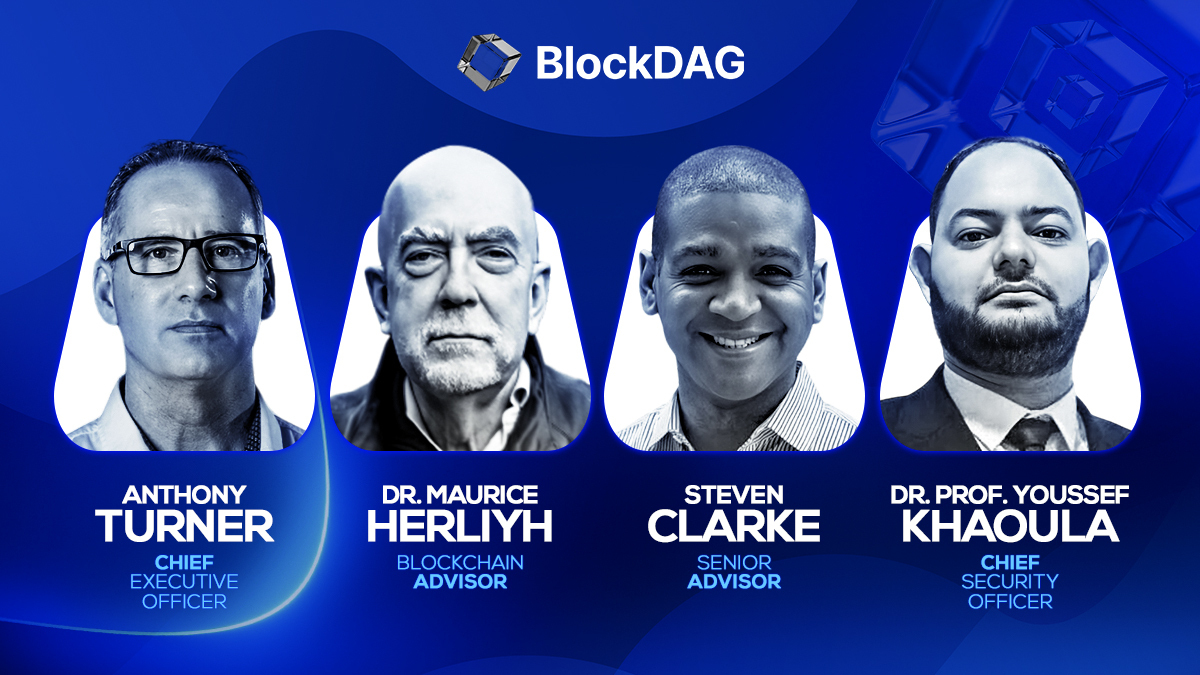
BlockDAG Network’s history is one of innovation, perseverance, and a vision to push the boundaries of blockchain technology. With Harvard alumni, tech moguls, and best-selling authors at the helm, BlockDAG is rewriting the rules of the cryptocurrency game.
CEO Antony Turner, inspired by the successes and shortcomings of Bitcoin and Ethereum, says, “BlockDAG leverages existing technology to push the boundaries of speed, security, and decentralization.” This powerhouse team has led a staggering 1,600% price increase in 20 pre-sale rounds, raising over $63.9 million. The secret? Unparalleled expertise and a bold vision for the future of blockchain.
Let’s dive into BlockDAG’s success story and find out what the future holds for this cryptocurrency.
The Origin: Why BlockDAG Was Created
In a recent interview, BlockDAG CEO Antony Turner perfectly summed up why the market needs BlockDAG’s ongoing revolution. He said:
“The creation of BlockDAG was inspired by Bitcoin and Ethereum, their successes and their shortcomings.
If you look at almost any new technology, it is very rare that the first movers remain at the forefront forever. Later incumbents have a huge advantage in entering a market where the need has been established and the technology is no longer cutting edge.
BlockDAG has done just that: our innovation is incorporating existing technology to provide a better solution, allowing us to push the boundaries of speed, security, and decentralization.”
The Present: How Far Has BlockDAG Come?
BlockDAG’s presale is setting new benchmarks in the cryptocurrency investment landscape. With a stunning 1600% price increase over 20 presale lots, it has already raised over $63.9 million in capital, having sold over 12.43 billion BDAG coins.
This impressive performance underscores the overwhelming confidence of investors in BlockDAG’s vision and leadership. The presale attracted over 20,000 individual investors, with the BlockDAG community growing exponentially by the hour.
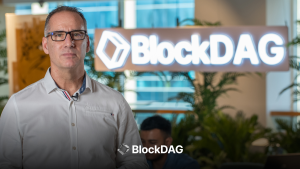
These monumental milestones have been achieved thanks to the unparalleled skills, experience and expertise of BlockDAG’s management team:
Antony Turner – Chief Executive Officer
Antony Turner, CEO of BlockDAG, has over 20 years of experience in the Fintech, EdTech, Travel and Crypto industries. He has held senior roles at SPIRIT Blockchain Capital and co-founded Axona-Analytics and SwissOne. Antony excels in financial modeling, business management and scaling growth companies, with expertise in trading, software, IoT, blockchain and cryptocurrency.
Director of Communications
Youssef Khaoulaj, CSO of BlockDAG, is a Smart Contract Auditor, Metaverse Expert, and Red Team Hacker. He ensures system security and disaster preparedness, and advises senior management on security issues.
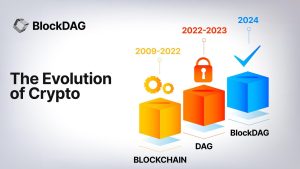
advisory Committee
Steven Clarke-Martin, a technologist and consultant, excels in enterprise technology, startups, and blockchain, with a focus on DAOs and smart contracts. Maurice Herlihy, a Harvard and MIT graduate, is an award-winning computer scientist at Brown University, with experience in distributed computing and consulting roles, most notably at Algorand.
The Future: Becoming the Cryptocurrency with the Highest Market Cap in the World
Given its impressive track record and a team of geniuses working tirelessly behind the scenes, BlockDAG is quickly approaching the $600 million pre-sale milestone. This crypto powerhouse will soon enter the top 30 cryptocurrencies by market cap.
Currently trading at $0.017 per coin, BlockDAG is expected to hit $1 million in the coming months, with the potential to hit $30 per coin by 2030. Early investors have already enjoyed a 1600% ROI by batch 21, fueling a huge amount of excitement around BlockDAG’s presale. The platform is seeing significant whale buying, and demand is so high that batch 21 is almost sold out. The upcoming batch is expected to drive prices even higher.

Invest in BlockDAG Pre-Sale Now:
Pre-sale: https://purchase.blockdag.network
Website: https://blockdag.network
Telegram: https://t.me/blockDAGnetwork
Discord: Italian: https://discord.gg/Q7BxghMVyu
No spam, no lies, just insights. You can unsubscribe at any time.
Tech
How Karak’s Latest Tech Integration Could Make Data Breaches Obsolete
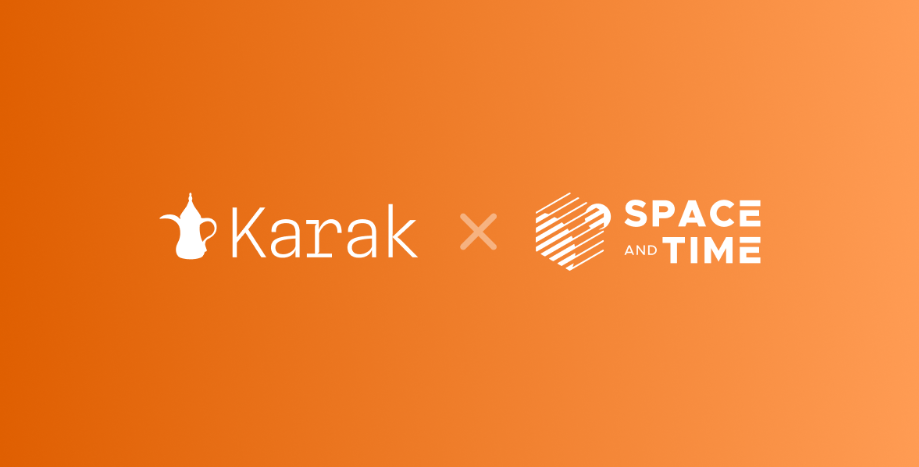
- Space and Time uses zero-knowledge proofs to ensure secure and tamper-proof data processing for smart contracts and enterprises.
- The integration facilitates faster development and deployment of Distributed Secure Services (DSS) on the Karak platform.
Karak, a platform known for its strong security capabilities, is enhancing its Distributed Secure Services (DSS) by integrating Space and Time as a zero-knowledge (ZK) coprocessor. This move is intended to strengthen trustless operations across its network, especially in slashing and rewards mechanisms.
Space and Time is a verifiable processing layer that uses zero-knowledge proofs to ensure that computations on decentralized data warehouses are secure and untampered with. This system enables smart contracts, large language models (LLMs), and enterprises to process data without integrity concerns.
The integration with Karak will enable the platform to use Proof of SQL, a new ZK-proof approach developed by Space and Time, to confirm that SQL query results are accurate and have not been tampered with.
One of the key features of this integration is the enhancement of DSS on Karak. DSS are decentralized services that use re-staked assets to secure the various operations they provide, from simple utilities to complex marketplaces. The addition of Space and Time technology enables faster development and deployment of these services, especially by simplifying slashing logic, which is critical to maintaining security and trust in decentralized networks.
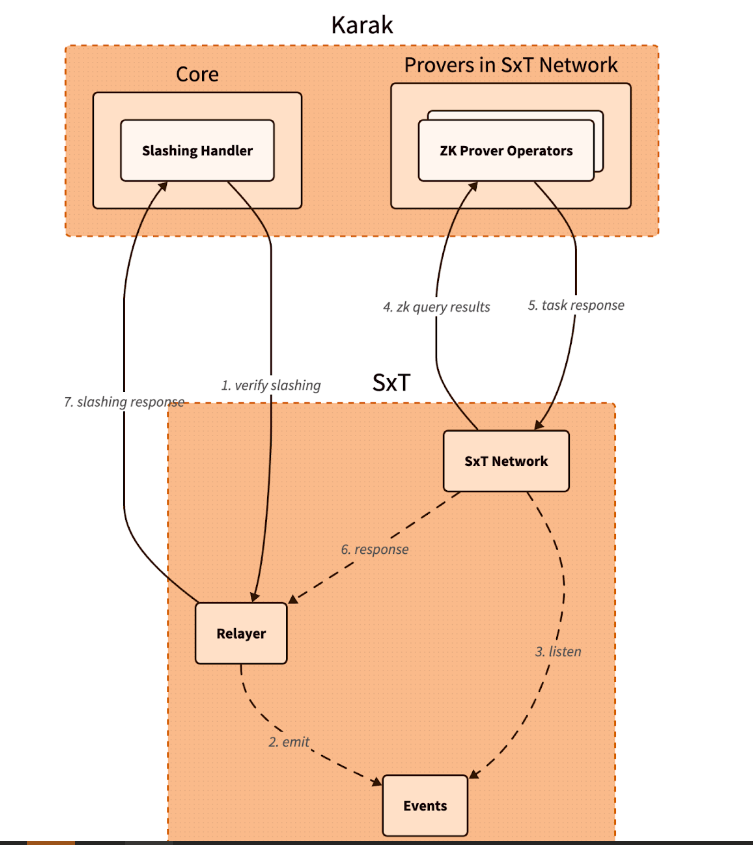
Additionally, Space and Time is developing its own DSS for blockchain data indexing. This service will allow community members to easily participate in the network by running indexing nodes. This is especially beneficial for applications that require high security and decentralization, such as decentralized data indexing.
The integration architecture follows a detailed and secure flow. When a Karak slashing contract needs to verify a SQL query, it calls the Space and Time relayer contract with the required SQL statement. This contract then emits an event with the query details, which is detected by operators in the Space and Time network.
These operators, responsible for indexing and monitoring DSS activities, validate the event and route the work to a verification operator who runs the query and generates the necessary ZK proof.
The result, along with a cryptographic commitment on the queried data, is sent to the relayer contract, which verifies and returns the data to the Karak cutter contract. This end-to-end process ensures that the data used in decision-making, such as determining penalties within the DSS, is accurate and reliable.
Karak’s mission is to provide universal security, but it also extends the capabilities of Space and Time to support multiple DSSs with their data indexing needs. As these technologies evolve, they are set to redefine the secure, decentralized computing landscape, making it more accessible and efficient for developers and enterprises alike. This integration represents a significant step towards a more secure and verifiable digital infrastructure in the blockchain space.
Website | X (Twitter) | Discord | Telegram
No spam, no lies, just insights. You can unsubscribe at any time.
Tech
Cryptocurrency Payments: Should CFOs Consider This Ferrari-Approved Trend?

Iconic Italian luxury carmaker Ferrari has announced the expansion of its cryptocurrency payment system to its European dealer network.
The move, which follows a successful launch in North America less than a year ago, raises a crucial question for CFOs across industries: Is it time to consider accepting cryptocurrency as a form of payment for your business?
Ferrari’s move isn’t an isolated one. It’s part of a broader trend of companies embracing digital assets. As of 2024, we’re seeing a growing number of companies, from tech giants to traditional retailers, accepting cryptocurrencies.
This change is determined by several factors:
- Growing mainstream adoption of cryptocurrencies
- Growing demand from tech-savvy and affluent consumers
- Potential for faster and cheaper international transactions
- Desire to project an innovative brand image
Ferrari’s approach is particularly noteworthy. They have partnered with BitPay, a leading cryptocurrency payment processor, to allow customers to purchase vehicles using Bitcoin, Ethereum, and USDC. This satisfies their tech-savvy and affluent customer base, many of whom have large digital asset holdings.
Navigating Opportunities and Challenges
Ferrari’s adoption of cryptocurrency payments illustrates several key opportunities for companies considering this move. First, it opens the door to new customer segments. By accepting cryptocurrency, Ferrari is targeting a younger, tech-savvy demographic—people who have embraced digital assets and see them as a legitimate form of value exchange. This strategy allows the company to connect with a new generation of affluent customers who may prefer to conduct high-value transactions in cryptocurrency.
Second, cryptocurrency adoption increases global reach. International payments, which can be complex and time-consuming with traditional methods, become significantly easier with cryptocurrency transactions. This can be especially beneficial for businesses that operate in multiple countries or deal with international customers, as it potentially reduces friction in cross-border transactions.
Third, accepting cryptocurrency positions a company as innovative and forward-thinking. In today’s fast-paced business environment, being seen as an early adopter of emerging technologies can significantly boost a brand’s image. Ferrari’s move sends a clear message that they are at the forefront of financial innovation, which can appeal to customers who value cutting-edge approaches.
Finally, there is the potential for cost savings. Traditional payment methods, especially for international transactions, often incur substantial fees. Cryptocurrency transactions, on the other hand, can offer lower transaction costs. For high-value purchases, such as luxury cars, these savings could be significant for both the business and the customer.
While the opportunities are enticing, accepting cryptocurrency payments also presents significant challenges that businesses must address. The most notable of these is volatility. Cryptocurrency values can fluctuate dramatically, sometimes within hours, posing potential risk to businesses that accept them as payment. Ferrari addressed this challenge by implementing a system that instantly converts cryptocurrency received into traditional fiat currencies, effectively mitigating the risk of value fluctuations.
Regulatory uncertainty is another major concern. The legal landscape surrounding cryptocurrencies is still evolving in many jurisdictions around the world. This lack of clear and consistent regulations can create compliance challenges for companies, especially those operating internationally. Companies must remain vigilant and adaptable as new laws and regulations emerge, which can be a resource-intensive process.
Implementation costs are also a significant obstacle. Integrating cryptocurrency payment systems often requires substantial investment in new technology infrastructure and extensive staff training. This can be especially challenging for small businesses or those with limited IT resources. The costs are not just financial; a significant investment of time is also required to ensure smooth implementation and operation.
Finally, security concerns loom large in the world of cryptocurrency transactions. While blockchain technology offers some security benefits, cryptocurrency transactions still require robust cybersecurity measures to protect against fraud, hacks, and other malicious activity. Businesses must invest in robust security protocols and stay up-to-date on the latest threats and protections, adding another layer of complexity and potential costs to accepting cryptocurrency payments.
Strategic Considerations for CFOs
If you’re thinking of following in Ferrari’s footsteps, here are the key factors to consider:
- Risk Assessment: Carefully evaluate potential risks to your business, including financial, regulatory, and reputational risks.
- Market Analysis: Evaluate whether your customer base is significantly interested in using cryptocurrencies for payments.
- Technology Infrastructure: Determine the costs and complexities of implementing a cryptographic payment system that integrates with existing financial processes.
- Regulatory Compliance: Ensure that cryptocurrency acceptance is in line with local regulations in all markets you operate in. Ferrari’s gradual rollout demonstrates the importance of this consideration.
- Financial Impact: Analyze how accepting cryptocurrency could impact your cash flow, accounting practices, and financial reporting.
- Partnership Evaluation: Consider partnering with established crypto payment processors to reduce risk and simplify implementation.
- Employee Training: Plan comprehensive training to ensure your team is equipped to handle cryptocurrency transactions and answer customer questions.
While Ferrari’s adoption of cryptocurrency payments is exciting, it’s important to consider this trend carefully.
A CFO’s decision to adopt cryptocurrency as a means of payment should be based on a thorough analysis of your company’s specific needs, risk tolerance, and strategic goals. Cryptocurrency payments may not be right for every business, but for some, they could provide a competitive advantage in an increasingly digital marketplace.
Remember that the landscape is rapidly evolving. Stay informed about regulatory changes, technological advancements, and changing consumer preferences. Whether you decide to accelerate your crypto engines now or wait in the pit, keeping this payment option on your radar is critical to navigating the future of business transactions.
Was this article helpful?
Yes No
Sign up to receive your daily business insights
Tech
Bitcoin Tumbles as Crypto Market Selloff Mirrors Tech Stocks’ Plunge
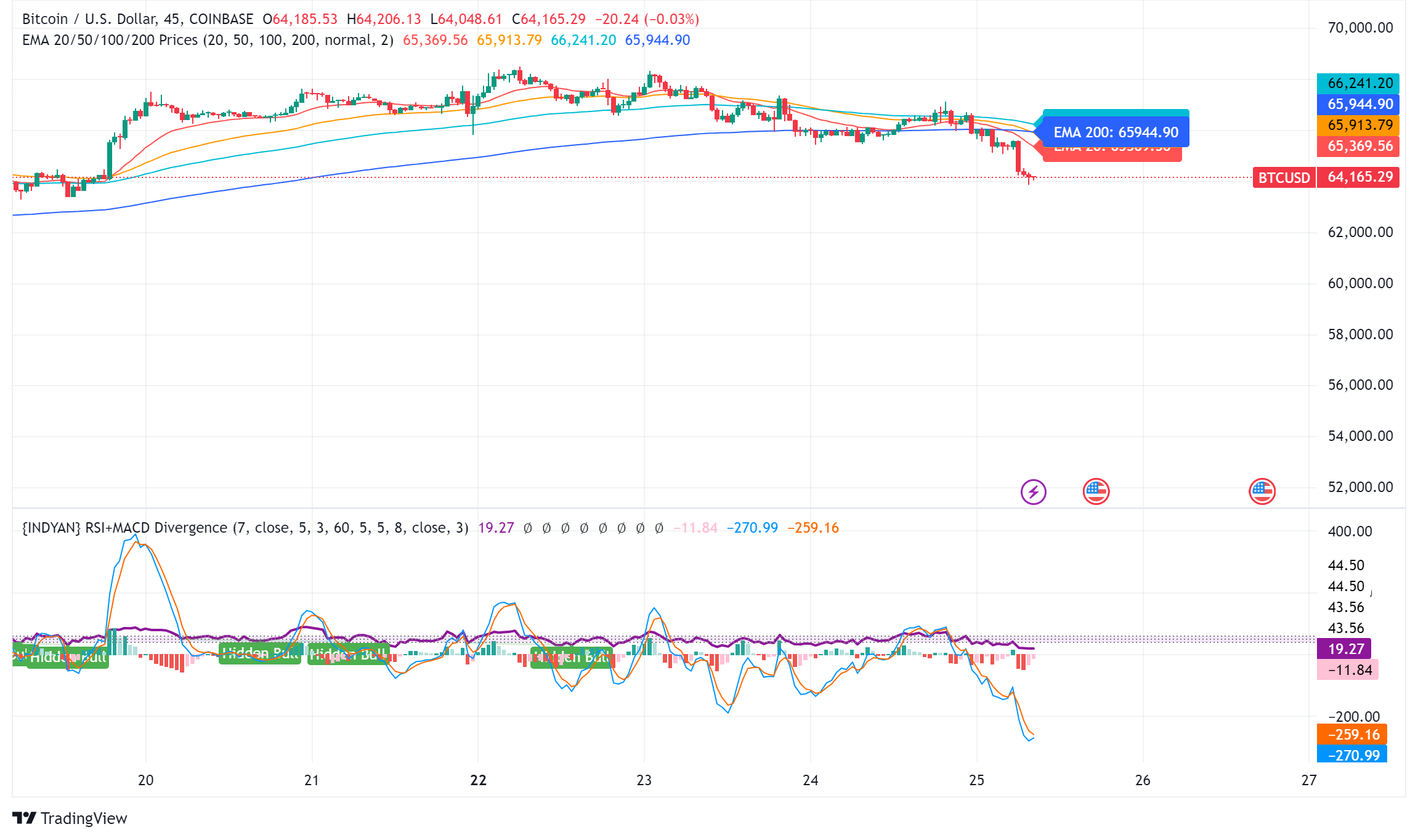
The world’s largest cryptocurrency, Bitcoin (BTC), suffered a significant price decline on Wednesday, falling below $65,000. The decline coincides with a broader market sell-off that has hit technology stocks hard.
Cryptocurrency Liquidations Hit Hard
CoinGlass data reveals a surge in long liquidations in the cryptocurrency market over the past 24 hours. These liquidations, totaling $220.7 million, represent forced selling of positions that had bet on price increases. Bitcoin itself accounted for $14.8 million in long liquidations.
Ethereum leads the decline
Ethereal (ETH), the second-largest cryptocurrency, has seen a steeper decline than Bitcoin, falling nearly 8% to trade around $3,177. This decline mirrors Bitcoin’s price action, suggesting a broader market correction.
Cryptocurrency market crash mirrors tech sector crash
The cryptocurrency market decline appears to be linked to the significant losses seen in the U.S. stock market on Wednesday. Stock market listing The index, heavily weighted toward technology stocks, posted its sharpest decline since October 2022, falling 3.65%.
Analysts cite multiple factors
Several factors may have contributed to the cryptocurrency market crash:
- Tech earnings are underwhelming: Earnings reports from tech giants like Alphabet are disappointing (Google(the parent company of), on Tuesday, triggered a sell-off in technology stocks with higher-than-expected capital expenditures that could have repercussions on the cryptocurrency market.
- Changing Political Landscape: The potential impact of the upcoming US elections and changes in Washington’s policy stance towards cryptocurrencies could influence investor sentiment.
- Ethereal ETF Hopes on the line: While bullish sentiment around a potential U.S. Ethereum ETF initially boosted the market, delays or rejections could dampen enthusiasm.
Analysts’ opinions differ
Despite the short-term losses, some analysts remain optimistic about Bitcoin’s long-term prospects. Singapore-based cryptocurrency trading firm QCP Capital believes Bitcoin could follow a similar trajectory to its post-ETF launch all-time high, with Ethereum potentially converging with its previous highs on sustained institutional interest.
Rich Dad Poor Dad Author’s Prediction
Robert Kiyosaki, author of the best-selling Rich Dad Poor Dad, predicts a potential surge in the price of Bitcoin if Donald Trump is re-elected as US president. He predicts a surge to $105,000 per coin by August 2025, fueled by a weaker dollar that is set to boost US exports.
BTC/USD Technical Outlook
Bitcoin price is currently trading below key support levels, including the $65,500 level and the 100 hourly moving average. A break below the $64,000 level could lead to further declines towards the $63,200 support zone. However, a recovery above the $65,500 level could trigger another increase in the coming sessions.
-

 Videos4 weeks ago
Videos4 weeks agoAbsolutely massive: the next higher Bitcoin leg will shatter all expectations – Tom Lee
-

 News12 months ago
News12 months agoVolta Finance Limited – Director/PDMR Shareholding
-

 News12 months ago
News12 months agoModiv Industrial to release Q2 2024 financial results on August 6
-

 News12 months ago
News12 months agoApple to report third-quarter earnings as Wall Street eyes China sales
-

 News12 months ago
News12 months agoNumber of Americans filing for unemployment benefits hits highest level in a year
-
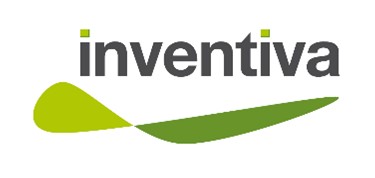
 News1 year ago
News1 year agoInventiva reports 2024 First Quarter Financial Information¹ and provides a corporate update
-

 News1 year ago
News1 year agoLeeds hospitals trust says finances are “critical” amid £110m deficit
-

 Markets1 year ago
Markets1 year agoWhale Investments in Bitcoin Hit $100 Billion in 2024, Fueling Insane Investor Optimism ⋆ ZyCrypto
-
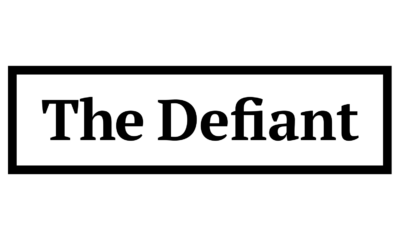
 DeFi1 year ago
DeFi1 year ago🏴☠️ Pump.Fun operated by Insider Exploit
-

 Videos1 year ago
Videos1 year ago$1,000,000 worth of BTC in 2025! Get ready for an UNPRECEDENTED PRICE EXPLOSION – Jack Mallers
-

 Videos1 year ago
Videos1 year agoABSOLUTELY HUGE: Bitcoin is poised for unabated exponential growth – Mark Yusko and Willy Woo
-

 Tech1 year ago
Tech1 year agoBlockDAG ⭐⭐⭐⭐⭐ Review: Is It the Next Big Thing in Cryptocurrency? 5 questions answered












